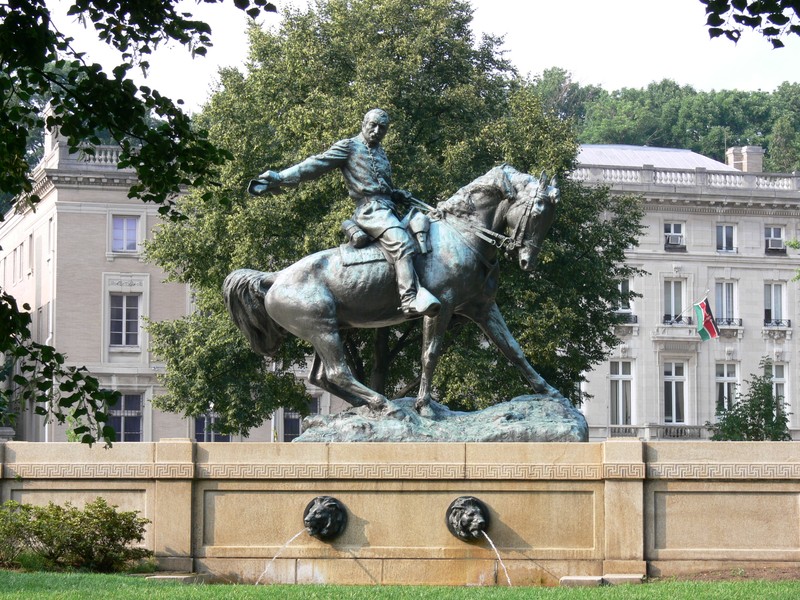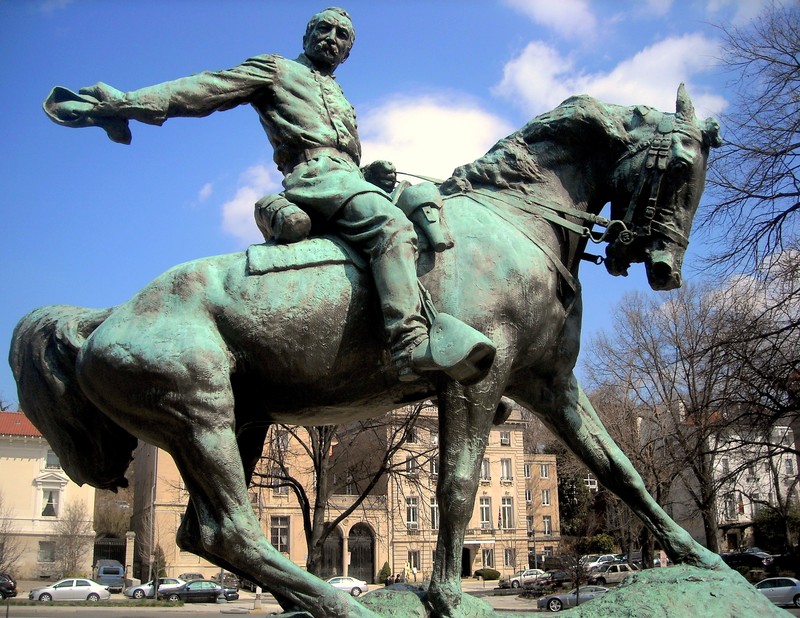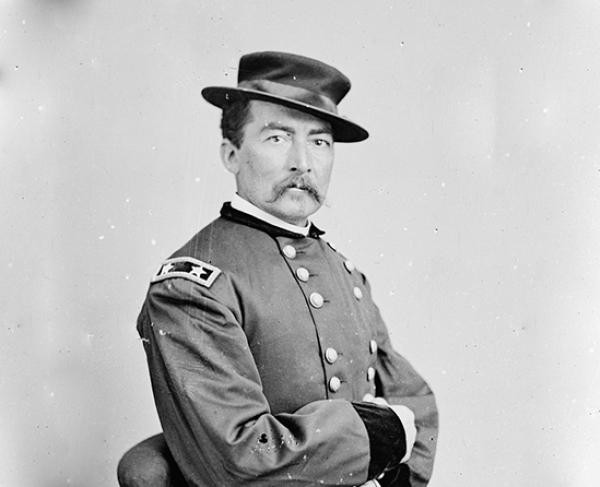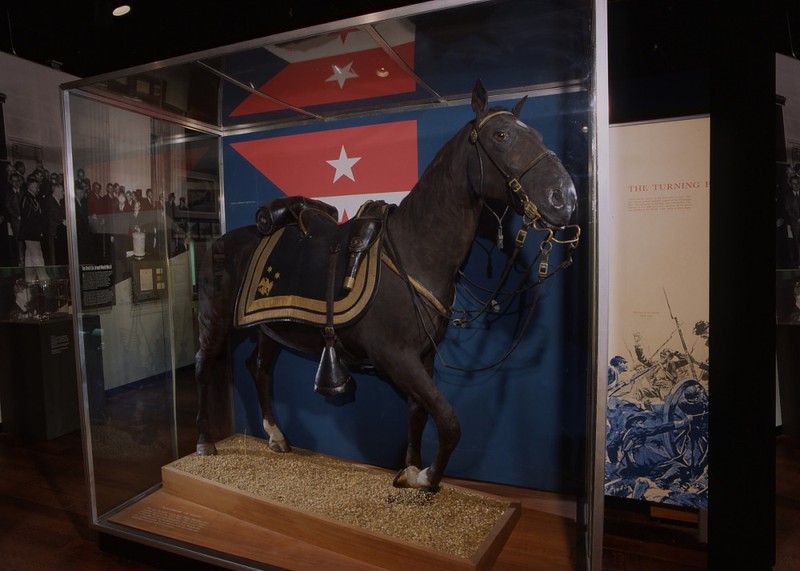General Philip Sheridan Memorial
Introduction
Text-to-speech Audio
Images
General Philip Sheridan Memorial in Sheridan Circle in Washington, D.C.

A closer look at the bronze equestrian statue

Philip H. Sheridan (1831-1888)

Sheridan horse, Rienzi (later renamed Winchester), on display at the Smithsonian National Museum of American History in Washington, D.C.

Backstory and Context
Text-to-speech Audio
Philip Henry Sheridan was born on March 6, 1831. Exactly where he was born, however, is uncertain. Some scholars argue that it was Albany, New York. Others contend that he was born in Boston, Ireland, or at sea while his Irish parents were immigrating to the United States. What is certain, however, is that he grew up in Somerset, Ohio, where he received a common school education and worked as a bookkeeper and clerk in local stores. Inspired by stories from the Mexican War (1846-1848), Sheridan decide to pursue a career in the military. In 1848, he secured an appointment to the United States Military Academy at West Point. Despite a physical altercation with a fellow cadet that resulted in a year-long suspension from the academy, Sheridan graduated in 1853. Over the next several years, he served in California, Texas, and the Pacific Northwest, where he fought against, and conducted negotiations with, various Native American groups.
In May 1862, just over a year after the outbreak of the Civil War, Sheridan received a commission as colonel of the Second Michigan Cavalry. That July, he led his regiment to victory at the Battle of Booneville. For his conduct during the engagement, Sheridan received a promotion to the rank of brigadier general of volunteers and took command of an infantry division in the Army of the Ohio (later renamed the Army of the Cumberland). After participating in the Battle of Stones River, he received another promotion, this time to the rank of major general of volunteers. In late November 1863, Sheridan and his men helped to capture Missionary Ridge just outside of Chattanooga, a move that enabled Union forces to seize the vital railroad junction. When Ulysses S. Grant assumed command of all union armies in early 1864, he brought Sheridan east to take command of the Army of the Potomac’s cavalry corps. During his time in the position, Sheridan fought Confederate General J.E.B. Stuart at the Battle of Yellow Tavern (May 1864). The engagement not only resulted in a Union victory, but also resulted in the death of Stuart, the Confederacy’s most able cavalry officer. Later that same year, Sheridan took command of the Army of the Shenandoah. His objective was to drive Confederate forces from Virginia’s Shenandoah Valley and cripple the area’s ability to supply Richmond and rebel forces in the field. After defeating Confederate General Jubal Early in two separate engagements and taking control of the valley, Sheridan systematically destroyed barns, crops, livestock, and mills. Remembered as “The Burning” by residents, it impaired the Confederacy’s ability to make war and dealt a severe blow to southern morale. In October, Early surprised Sheridan’s army at Cedar Creek while their commander was ten miles away in Winchester. The Confederate attack sent the federal troops fleeing, but Sheridan’s quick return helped to rally the men in blue and eventually win the day. Following the battle, Sheridan received a promotion to the rank of major general in the regular army, in addition to thanks from Congress and President Abraham Lincoln. In the final weeks of the war, he helped harass and trap Confederate General Robert E. Lee’s Army of Northern Virginia, leading to its surrender on April 9, 1865.
Following the war, Sheridan served as the military governor of the Fifth Military District (Louisiana and Texas) during Reconstruction, but was removed from the position by President Andrew Johnson for imposing Reconstruction policies too harshly. He then carried out a campaign against Plains Indians using the same tactics he employed in the Shenandoah Valley in 1864. For his efforts, Sheridan received a promotion to the rank of lieutenant general. In 1883, he became general-in-chief of the U.S. Army and General of the Army of the United States in 1888. Later that same year, Sheridan died in Nonquitt, Massachusetts after suffering a series of heart attacks at the age of fifty-seven. His remains were buried in Arlington National Cemetery.
Four years after Sheridan’s death, the Society of the Army of the Cumberland commissioned sculptor John Quincy Adams Ward to complete an equestrian statue of the general by 1898. When the deadline arrived, Ward had only minimal progress to show. Frustrated by Ward’s glacial pace, the Union veterans’ organization canceled the contract in 1905. The artist later sued, but lost. Two years after cancelling its contract with Ward, the society commissioned sculptor Gutzon Borglum (who later became famous for Mount Rushmore) to complete the project. Dedicated on November 25, 1908 in Washington, D.C.’s Sheridan Circle, the bronze sculpture stands on a small rectangular granite base and depicts Sheridan atop his loyal steed, Rienzi, rallying his troops at Cedar Creek. The statue and its base rest on a large rectangular plaza, which features two sets of steps leading up the sculpture and two sets of bronze lion heads on each side that spout water into basins below. In attendance at the unveiling ceremony, among others, were President Theodore Roosevelt, Sheridan’s wife and son, and innumerable Civil War veterans.
Cite This Entry
Lenox, Laney, Francis Curran, and James TUcker. "General Philip Sheridan Memorial." Clio: Your Guide to History. April 20, 2021. Accessed April 16, 2025. https://theclio.com/tour/47/19
Sources
"General Philip Sheridan, (sculpture)." Art Inventories Catalog. Smithsonian American Art Museum. Smithsonian Institution Research Information System (SIRIS). Web. 20 April 2021 <https://siris-artinventories.si.edu/ipac20/ipac.jsp?&profile=all&source=~!siartinventories&uri=full=3100001~!16268~!0#focus>.
"General Philip Sheridan Memorial." NPS.gov. U.S. Department of the Interior. 28 October 2020. Web. 20 April 2021 <https://www.nps.gov/places/000/general-phillip-sheridan-memorial.htm>.
History.com Editors. "Philip Sheridan." History. A&E Television Networks. 21 August 2018. Web. 20 April 2021 <https://www.history.com/topics/american-civil-war/philip-sheridan>.
Jacob, Kathryn Allamong. Testament to Union: Civil War Monuments in Washington, D.C. Baltimore: The Johns Hopkins University Press, 1998.
"Philip H. Sheridan." Encyclopædia Britannica. 2 March 2021. Web. 20 April 2021 <https://www.britannica.com/biography/Philip-H-Sheridan>.
"Philip Sheridan." battlefields.org. American Battlefield Trust. Web. 20 April 2021 <https://www.battlefields.org/learn/biographies/philip-sheridan>.
Wright, John D. The Routledge Encyclopedia of Civil War Era Biographies. New York: Routledge, 2013.
https://en.wikipedia.org/wiki/Equestrian_statue_of_Philip_Sheridan
https://en.wikipedia.org/wiki/Sheridan_Circle
https://www.battlefields.org/learn/biographies/philip-sheridan
https://americanhistory.si.edu/collections/search/object/nmah_439678

